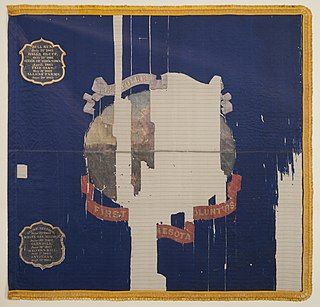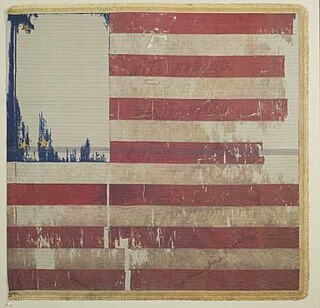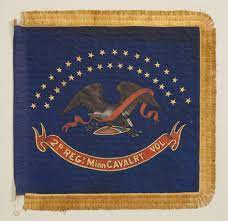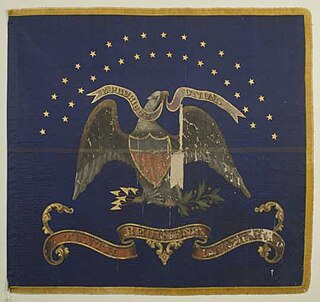
The Minnesota Democratic–Farmer–Labor Party (DFL) is a political party in the U.S. state of Minnesota affiliated with the national Democratic Party. The party was formed by a merger between the Minnesota Democratic Party and the Minnesota Farmer–Labor Party in 1944. The DFL is one of two state Democratic Party affiliates with a different name from that of the national party, the other is the neighboring North Dakota Democratic–Nonpartisan League Party.

Fort Snelling is a former military fortification and National Historic Landmark in the U.S. state of Minnesota on the bluffs overlooking the confluence of the Minnesota and Mississippi Rivers. The military site was initially named Fort Saint Anthony, but it was renamed Fort Snelling once its construction was completed in 1825.

Alexander Ramsey was an American politician, who became the first Minnesota Territorial Governor and later became a U.S. Senator. He served as a Whig and Republican over a variety of offices between the 1840s and the 1880s.

The 1st Minnesota Infantry Regiment was a Union infantry regiment active during the American Civil War. The 1st Minnesota participated in the battles of First Bull Run, Antietam and the Battle of Gettysburg. One of the regiment's most famous actions was on the second day of the Battle of Gettysburg when Major General Winfield Scott Hancock ordered the 1st Minnesota to charge into a brigade of 1,200 Confederate soldiers. This action blunted the Confederate attack and helped preserve the Union's precarious position on Cemetery Ridge.

Fort Ridgely was a frontier United States Army outpost from 1851 to 1867, built 1853–1854 in Minnesota Territory. The Sioux called it Esa Tonka. It was located overlooking the Minnesota River southwest of Fairfax, Minnesota. Half of the fort's land was part of the south reservation in the Minnesota river valley for the Mdewakanton and Wahpekute tribes. Fort Ridgely had no defensive wall, palisade, or guard towers. The Army referred to the fort as the "New Post on the Upper Minnesota" until it was named for two Maryland Army Officers named Ridgely, who died during the Mexican–American War.
Mississippi River Band of Chippewa Indians or simply the Mississippi Chippewa, are a historical Ojibwa Band inhabiting the headwaters of the Mississippi River and its tributaries in present-day Minnesota.

The Minnesota National Guard is a state-based military force of more than 13,000 soldiers and airmen, serving in 61 communities across the state. Operated in the U.S. state of Minnesota, it is a reserve component of the National Guard.

The 2nd Minnesota Infantry Regiment was a Minnesota USV infantry regiment that served in the Union Army during the American Civil War. The regiment went on to campaign in the south and especially distinguish itself at the battles of Mill Springs, Chickamauga, and Missionary Ridge.

The 2nd Minnesota Cavalry Regiment was a Minnesota USV cavalry regiment that served in the Union Army during the American Civil War.

The 8th Minnesota Infantry Regiment was a Minnesota USV infantry regiment that served in the Union Army during the American Indian Wars and the American Civil War.

The 10th Minnesota Infantry Regiment was a Minnesota USV infantry regiment that served in the Union Army during the American Civil War.

Hatch's Minnesota Cavalry Battalion was a Minnesota USV cavalry battalion that served in the Union Army during the American Civil War and American Indian Wars.

The 3rd Minnesota Light Artillery Battery was a Minnesota USV artillery battery that served in the Union Army during the American Civil War and the American Indian Wars.

The Dakota War of 1862, also known as the Sioux Uprising, the Dakota Uprising, the Sioux Outbreak of 1862, the Dakota Conflict, or Little Crow's War, was an armed conflict between the United States and several eastern bands of Dakota collectively known as the Santee Sioux. It began on August 18, 1862, when the Dakota, who were facing starvation and displacement, attacked white settlements at the Lower Sioux Agency along the Minnesota River valley in southwest Minnesota. The war lasted for five weeks and resulted in the deaths of hundreds of settlers and the displacement of thousands more. In the aftermath, the Dakota people were exiled from their homelands, forcibly sent to reservations in the Dakotas and Nebraska, and the State of Minnesota confiscated and sold all their remaining land in the state. The war also ended with the largest mass execution in United States history with the hanging of 38 Dakota men.

Minnesota Amendment 1 was a legislatively referred constitutional amendment proposed to ban marriage between same-sex couples in the state of Minnesota, that appeared on the ballot on November 6, 2012. It was rejected by 51.19% of voters.

Hole-in-the-Day was a prominent chief of the Mississippi band of Ojibwe/Chippewa in Minnesota. The native pronunciation has been written with different spellings due different speakers variance in their enunciation, such as Bagone-giizhig, Bagwunagijik, Bug-o-nay-ki-shig, Pugonakeshig or Puk-O-Nay-Keshig. Hole-in-the-Day has also been called Hole-in-the-Sky. The name refers to a dream in which the guardian spirit was seen through an opening in the clouds. It also refers to the Anishinaabek name for the constellation of the same name, also known as the Pleiades.

Mary Kelly Kunesh is an American politician and member of the Minnesota State Senate. A member of the Minnesota Democratic–Farmer–Labor Party (DFL), she represents District 39, which includes parts of the counties of Ramsey, Hennepin, and Anoka, and the cities of Fridley, Spring Lake Park, Columbia Heights, Hilltop, New Brighton, and St. Anthony.

William Crooks was a Colonel during the American Civil War, member of the Minnesota House of Representatives, U.S. Military Academy graduate, and a veteran railroader. He led the 6th Regiment Minnesota Volunteer Infantry from August 1862 to October 1864, mainly contending against the Sioux. Crooks built the first rail line in the State of Minnesota, the St. Paul & Pacific. His first locomotive he named for himself the William Crooks 4-4-0 and began its operation in 1861. His operation was taken over by James J. Hill. The William Crooks would become the first locomotive of Hill's Great Northern Railroad.

The city of Saint Paul, Minnesota held an election on November 2, 2021, to elect the mayor. It was held with ranked-choice voting, and there was no primary election. Few candidates filed to challenge incumbent mayor Melvin Carter III, and he easily won a second term with over 60% of first-preference votes.

Henry Anson Castle was a lawyer, visionary, Civil War captain, and founder of the town of North St. Paul.




















